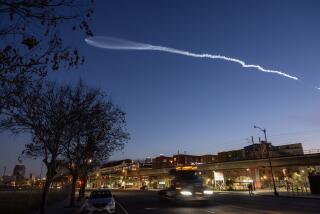Marine Commandant Stands Tall Against Airport Growth Plans
The Marine Corps unleashed its heavy artillery Wednesday as Commandant Gen. Alfred M. Gray flew to San Diego to announce that he will fight efforts by local governments to build airports at the Marine Corps Recruit Depot and Camp Pendleton.
“The Camp Pendleton situation and the (MCRD) situation are the same when it comes to the airport issue,” said Gray, a blunt and crusty veteran of two wars who worked his way up from the enlisted ranks. “I wish we had a better alternative, but we don’t.”
Gray, who was dressed in camouflage fatigues, landed on a green lawn at the MCRD in a UH-1N “Huey” helicopter. He is spending three days at Camp Pendleton, where he is conferring with senior Marine officers on combat readiness plans.
Recently, the San Diego Assn. of Governments (Sandag) and the Airport Site Coalition, an Orange County group, began separate studies of possible airport sites to expand or supplement Lindbergh Field and John Wayne Airport in Orange County.
Among the options studied by Sandag are expanding Lindbergh Field to the adjacent MCRD or moving all airport operations to Miramar Naval Air Station. The Orange County group decided on three possible sites for a new regional airport, including somewhere on the 125,000-acre Camp Pendleton.
However, Gray said that both Marine bases have shrunk considerably over the years and argued that putting an airport at either site would have a serious effect on field training. Besides a call for a new airport, Gray said, there are a number of proposals to build a highway through Camp Pendleton. These suggestions “pose great risks to the training we do at Camp Pendleton,” he said.
The commandant also brought a message from Navy Secretary H. Lawrence Garrett, who opposes efforts to build a civilian airport at Miramar Naval Air Station. According to Gray, Garrett said that “Miramar and MCRD are equally important for the Department of the Navy.”
Gray spoke extensively on the airport issue, but most of his remarks
were aimed at local recommendations to expand Lindbergh Field to the MCRD.
“The buck stops here, and the issue stops here. . . . There is no more acreage available,” Gray said. “ . . . From my vantage point, the MCRD is not an option. It’s a vital military installation. It shares top billing with our key facility at Miramar.”
Marine Corps officials have pointed repeatedly to a 1988 study by the Secretary of Defense’s Commission on Base Closure and Realignment that decided against closing MCRD because it meets a clear military need.
Covered 800 Acres
The MCRD trains about 55% of all Marine recruits. When it opened in 1923, MCRD covered 800 acres. But, in the ensuing years, the Corps has given more than half of the original tract to the city and the San Diego Unified Port District, which administers the airport. Today, the base covers 388 acres.
Gray also shot down suggestions that the Marines move the MCRD to Camp Pendleton and consolidate training programs, making the site available for airport use. Marine officials have estimated that it would cost $1 billion to build a new training facility at Camp Pendleton. Gray called the possibility of moving MCRD to another site a “very big, stupid ‘if.’ ”
“There is no viable alternative to what we do here. . . . We cannot duplicate what we have here, and, if we could for any reason, we could not afford it,” Gray said.
In addition to the prohibitive cost of moving MCRD, he said, there is not enough water available for both bases at Camp Pendleton. The camp gets its water from underground wells.
Gray also discussed the reported killing of Marine Lt. Col. William Richard Higgins, a United Nations observer in Lebanon who was kidnaped by a Muslim religious group. He said U.S. officials “have a pretty good idea of the organization and people behind” Higgins’ killing.
“We will continue everything possible to get Rich back, and to get the other prisoners back. Some call them hostages,” Gray said.
More to Read
Sign up for Essential California
The most important California stories and recommendations in your inbox every morning.
You may occasionally receive promotional content from the Los Angeles Times.










